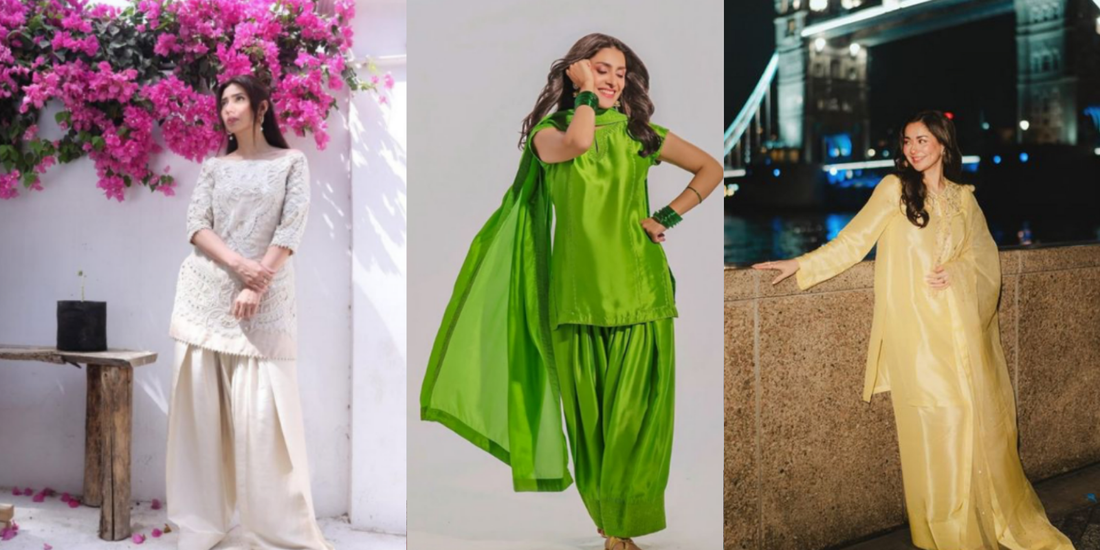
Farshi Shalwar Made a Grand Eid Comeback
Share
This Eid, rediscover timeless elegance as the Farshi Shalwar makes a regal comeback in the world of Pakistani Asian clothes.
This Eid, amidst the sea of pastel lawns, flowing abayas, and sleek silk kaftans, one trend rose above with an undeniable sense of nostalgia, elegance, and grandeur—the Farshi Shalwar Kameez A silhouette once reserved for Mughal royalty has made a dramatic return to the mainstream, worn by fashion-forward women looking to make a bold, cultural statement. As the twirling videos and graceful poses flooded social media, it was clear: the Farshi Shalwar was not just back—it was thriving.
The Royal Origins of the Farshi Shalwar
The Farshi Shalwar traces its roots back to the Mughal era, particularly during the 18th and 19th centuries. The word “Farshi” is derived from “farsh”, which means floor in Urdu, aptly named as the voluminous fabric often trails along the ground. It was traditionally worn by the Mughal aristocracy and Nawabi women in the Indian subcontinent, symbolizing luxury, prestige, and a leisurely lifestyle.
Unlike the modern churidar or cigarette pants, the Farshi Shalwar is known for its dramatic flair: multiple yards of fabric—sometimes up to 12 meters—are stitched in such a way that the garment fans out like a skirt at the bottom, while being fitted at the waist and hips. It’s often paired with equally ornate kurtas and dupattas, featuring detailed handwork like zardozi, Gota, Resham, and mukaish.
Wearing a Farshi Shalwar wasn’t just about style; it was about status. The sheer volume of fabric and the craftsmanship involved meant only women of higher social classes could afford to wear them. Over time, however, the trend faded with the advent of modernization and practicality. Until now.


Eid 2025: The Farshi Renaissance
Fashion is cyclical, and Pakistani designers have always shown a deep reverence for heritage wear. This Eid, the Farshi Shalwar returned with a vengeance—reimagined, repurposed, but retaining its regal DNA. From fashion weeks to Instagram reels, this iconic piece of Pakistani clothes made its way back into the limelight, proving that tradition can evolve while keeping its timeless charm.
This Eid, Araa proudly featured farshi shalwars from beloved brands like Khaadi and Zauk, fulfilling the festive fashion needs of our customers with elegance and ease. From traditional charm to modern flair, Araa brought the perfect blend of style and heritage straight to your doorstep.


Influencers and celebrities such as Ayeza Khan, Hania Aamir, and Mahira Khan were seen donning variations of the Farshi look, complete with old-world accessories: jhumkas, passas, teekas, and embroidered potlis. This helped bring the trend to a wider, younger audience who may have only seen such styles in old family photos or period dramas.
Modern Styling: Then vs. Now
The traditional Farshi Shalwar was a formal, heavy garment often paired with elaborate dupattas and long kameezes, making it perfect for special occasions like weddings or royal events. Today’s version, however, plays more with lengths, textures, and fabrics.
Modern adaptations of the Pakistani suit include:
Shorter Kurtas: To balance the volume of the shalwar, many have opted for hip-length or slightly above-the-knee kurtas.
Lightweight Fabrics: Instead of heavy brocades or velvets, contemporary Pakistani clothes are made with organza, net, tissue, or georgette to add fluidity and grace.
Minimal Embellishments: While some embrace the full Mughal fantasy, others choose minimal threadwork and subtle accents, allowing the cut and shape to shine
Why the Farshi Shalwar Trend Resonates Today
There’s something incredibly powerful about reclaiming traditional clothing in a modern world that often favors Western silhouettes. The revival of the Farshi Shalwar speaks to a growing desire for cultural roots, craftsmanship, and individuality.
Here’s why it resonated so strongly this Eid with Pakistani clothing:
Nostalgia: For many, the style harkened back to wedding photos of mothers and grandmothers, evoking a sense of familial pride.
Drama & Grace: In an age of minimalism, the Farshi Shalwar offers the opposite—drama, movement, and cinematic grace.
Cultural Expression: In globalized fashion spaces, wearing a Farshi Shalwar becomes an act of celebrating identity and history.
Body Inclusivity: Its voluminous structure flatters many body types, making it an inclusive silhouette across age groups.
The Role of Social Media
No trend exists today without the influence of social media—and the Farshi Shalwar, a regal variation of the shalwar kameez, is no exception. The garment practically begs to be twirled in, making it a favorite among those showcasing Pakistani clothes on Instagram. Slow-motion reels, close-ups of the intricate embroidery, and graceful Eid day portraits helped this timeless style go viral. TikTok and Instagram became runways of their own.
Moreover, many fashion bloggers used their platforms to educate audiences about the origins of the Farshi Shalwar, sparking conversations about preserving cultural attire and honoring the artisans behind such iconic Pakistani clothing.
Where Is the Trend Headed?
While the Farshi Shalwar made its major splash this Eid, its momentum shows no signs of slowing down. From classic Pakistani outfits to modern interpretations, designers are embracing its regal flair. Bridal wear experts are already incorporating it into mehndi and nikkah looks, while smaller boutiques are crafting custom pieces to meet growing demand. Even prêt-à-porter Shalwar kameez collections feature refined versions perfect for formal dinners and festive gatherings.
There’s room for even more experimentation—imagine Indo-Western fusion with Farshi pants paired with crop tops, or incorporating digital prints and modern motifs to make this piece a standout in your Pakistani Asian clothes collection. Whether it's a bold Eid outfit or an elegant party look, the Farshi Shalwar is reclaiming its throne in contemporary fashion.
Final Thoughts: Heritage with a Modern Heartbeat
The Farshi Shalwar’s return is more than just a fashion moment—it’s a cultural reclamation. In a fast-paced, globalized world, revisiting the elegance and artistry of the past can feel grounding. This Eid, Pakistani clothes didn’t just look good—they felt meaningful. They reminded us that in our closets lies not just fabric, but stories, legacy, and pride.
Whether you’re planning your next Eid outfit or looking ahead to wedding season, the Farshi Shalwar is capturing hearts once again. A true gem of Pakistani Asian clothes, it proves that some styles aren’t just timeless—they’re transformative.
One thing’s for sure: the Farshi Shalwar is no longer just history—it’s haute.
Get in touch with our experts at Araa — we're here to assist you every step of the way. Think of us as your personal shoppers, ready to curate the perfect look.
